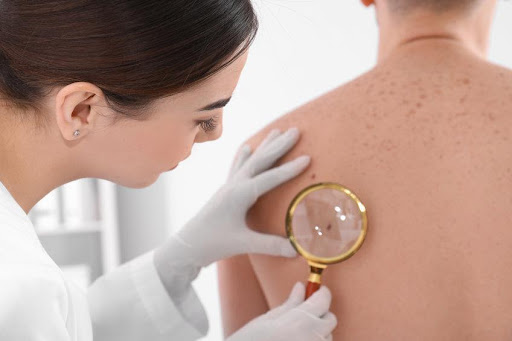
Understanding Skin Cancer
According to the Skin Cancer Foundation, 20 percent of Americans will develop skin cancer by 70. Unfortunately, it is one of the most common cancers with an aggressive mortality rate, with more than two people dying from skin cancer every two hours in the United States. Skin cancer is also preventable cancer and, when detected early, has a high survival rate.
May is Skin Cancer Awareness Month. It’s the perfect month to educate yourself about skin cancer, how to detect it early, and how to prevent it in the first place.
What is Skin Cancer
Skin cancer develops on the outer layer of the skin, the epidermis. Three types of cells make up the epidermis; squamous cells, basal cells, and melanocytes. Cancer most commonly starts in the squamous and basal cells, causing squamous and basal cell carcinomas, the two most common forms of skin cancer. Both squamous and basal cell carcinomas are treatable but may leave scars depending on the size and location of the cancer.
The third most common skin cancer is melanoma, when cancer starts in the melanocytes. Melanoma is a more aggressive form of skin cancer as it tends to spread throughout the body and may attack vital organs. Doctors can still treat melanoma, but it does have a significantly higher mortality rate than squamous and basal cell carcinomas.
Spotting Skin Cancer
The sooner you can detect skin cancer and treat it, the easier it is to cure and recover. Understanding how to spot skin cancer is key to early detection. Get familiar with your body and use the ABCDE rule to identify changes in your skin.
- A is for Asymmetry- Look for moles that have mismatched sides.
- B is for Border- Check for moles with irregular or jagged edges.
- C is for Color- Some concerning moles may have different colors, such as black, pink, white, or blue patches.
- D is for Diameter- Your mole should be no larger than ¼ inch in diameter.
- E is for Evolving- Get your mole checked by a dermatologist if it’s changing in size, shape, or color.
Preventing Skin Cancer
One of the primary risk factors for developing skin cancer is UV radiation exposure. Most people are exposed to UV radiation daily from the sun. It’s impractical to avoid UV radiation exposure, but there are steps you can take to protect your skin from harmful rays.
- Wear sunscreen daily. Most people know to apply sunscreen on warm days when they’re planning on spending a lot of time outside. But summer days are not the only time to protect your skin from the sun. Harmful UV rays can affect your skin, even on gloomy fall or winter days. That’s why it’s essential to incorporate sunscreen into your daily skincare routine. Apply sunscreen to any exposed areas, such as your face and neck.
- Avoid tanning beds. Tanning beds typically use UV rays for tanning the skin. Avoid tanning beds, and instead, use a self-tan lotion or cream to give yourself a glow.
- Cover up and seek shade. If you’re planning a day in direct sunlight, make sure you have shaded places to retreat to when you get too hot, even if you have sunscreen. If there are no shaded areas, wear breathable clothing and hats to keep the skin out of direct sunlight.
- Examine your body. Get to know your body and note any concerning spots or moles. It’s better to have your skin looked at by a professional if you’re concerned than to ignore a changing area that could lead to cancer. If you notice changes in your skin, contact your dermatologist.
If you’re a senior adult recently diagnosed with skin cancer and need assistance at home, the team at Visiting Angels can help. Our professional caregivers provide a range of services, including light housekeeping, medication reminders, appointment transportation, meal preparation, and mobility assistance. If you reside in Minneapolis, St. Louis Park, Golden Valley, Richfield, or the West Metro and would like to learn more about our services, call our St. Louis Park office at 952.935.0789.
